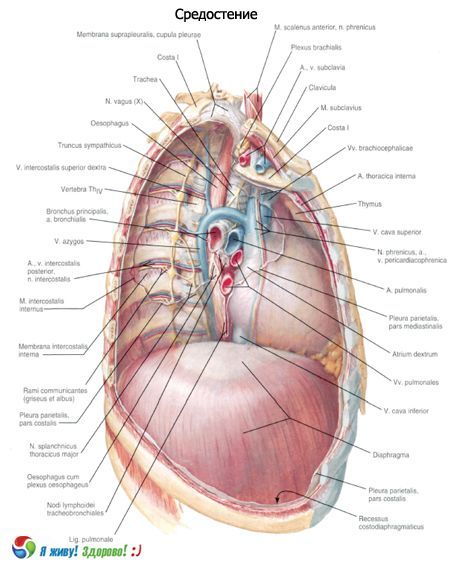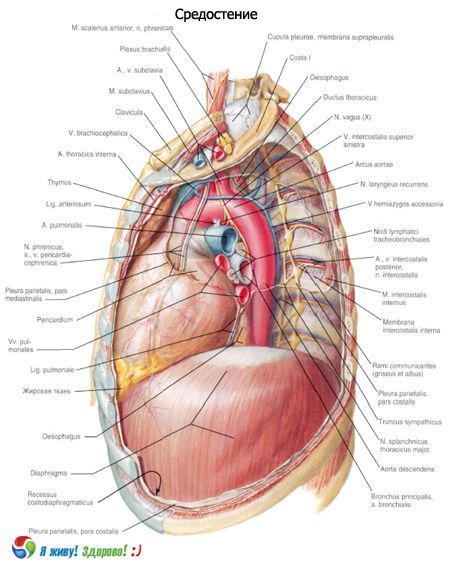Medical expert of the article
New publications
Mediastinum
Last reviewed: 07.07.2025

All iLive content is medically reviewed or fact checked to ensure as much factual accuracy as possible.
We have strict sourcing guidelines and only link to reputable media sites, academic research institutions and, whenever possible, medically peer reviewed studies. Note that the numbers in parentheses ([1], [2], etc.) are clickable links to these studies.
If you feel that any of our content is inaccurate, out-of-date, or otherwise questionable, please select it and press Ctrl + Enter.
The mediastinum is a part of the thoracic cavity bounded by the sternum in front, the spine in the back, and the right and left mediastinal pleura on the sides. The upper border of the mediastinum is the plane of the superior aperture of the thoracic cage, and the lower border is the diaphragm. The mediastinum is divided into upper and lower sections. The border between them is the plane connecting the angle of the sternum in front and the intervertebral disc between the IV and V thoracic vertebrae in the back. The upper section (superior mediastinum) (mediastinum superius) contains the thymus, right and left brachiocephalic veins, the initial section of the superior vena cava, the aortic arch and the beginning of the brachiocephalic trunk, the left common carotid artery and the left subclavian artery. The upper mediastinum also contains the trachea, the corresponding sections of the esophagus, the thoracic lymphatic duct, the sympathetic trunks, the vagus and phrenic nerves. The lower part of the mediastinum (lower mediastinum - mediastinum inferius) includes 3 parts: the anterior, middle and lower mediastinum.

The anterior mediastinum (mediastinum anterius) is located between the body of the sternum in front and the anterior surface of the pericardium behind. This section contains the internal thoracic arteries and veins, parathoracic and prepericardial lymph nodes.
The middle mediastinum (mediastinum medius) contains the heart with the pericardium covering it, the initial sections of the aorta, the pulmonary trunk, the final part of the superior and inferior vena cava, as well as the main bronchi, pulmonary arteries and veins, phrenic nerves, phrenic-pericardial vessels, inferior tracheobronchial and lateral pericardial lymph nodes.
The posterior mediastinum (mediastinum posterius) includes the organs located behind the pericardium. The thoracic aorta, the azygos and hemiazygos veins, the corresponding sections of the right and left sympathetic trunks, the greater and lesser splanchnic nerves, the vagus nerves, the esophagus, the thoracic duct, and the vertebral lymph nodes are located in the posterior mediastinum.

In clinical practice, the anterior and posterior mediastinum are usually distinguished, divided by a frontal plane drawn through the roots of the lungs. The anterior mediastinum contains the heart, pericardium, aortic arch, thymus, and phrenic nerves. The anterior mediastinum also contains the phrenic-pericardial and internal thoracic arteries and veins, parasternal, mediastinal, and superior phrenic lymph nodes. The posterior mediastinum contains the esophagus, thoracic aorta, thoracic duct, azygos and hemiazygos veins. The posterior mediastinum contains the vagus and visceral nerves, sympathetic trunks, posterior mediastinal, and prevertebral lymph nodes.
How to examine?


 [
[